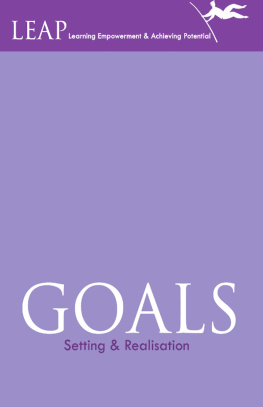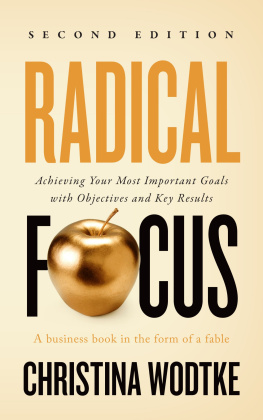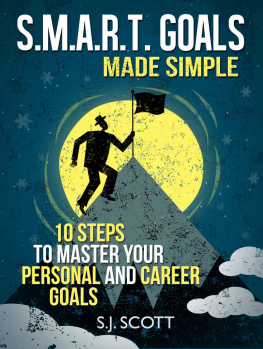Radical Focus
Achieving Your Most Important Goals with Objectives and Key Results
By Christina Wodtke
Content Copyright Christina Wodtke. All rights reserved. Published in the United States.
First Publishing Date, Beta Version under title The Executioners Tale, March 2014. First Edition of Radical Focus published January 2016.
Foreward
When Performance Is Measured By Results
By Marty Cagan, Founder of the Silicon Valley Product Group
I was extremely fortunate to have started my career at Hewlett-Packard as an engineer during their heyday, when they were known as the industrys most successful and enduring example of consistent innovation and execution. As part of HPs internal engineering management training program called The HP Way, I was introduced to a performance management system known as MBO - Management by Objectives.
The concept was straightforward, and based on two fundamental principles. The first can easily be summed up with the famous General George Patton quote: Dont tell people how to do things, tell them what you need done and let them surprise you with their results. The second was captured by HPs tagline of that era, When Performance Is Measured By Results. The idea here is that you can release all the features you want, but if it doesnt solve the underlying business problem, you havent really solved anything.
The first principle is really about how to motivate people to get them to do their best work, and the second is all about how to meaningfully measure progress.
So much has changed since my time at HP. The technologies are dramatically more advanced, the scale and scope of systems we build is several orders of magnitude larger, teams move much faster, generally with superior quality and performance, all delivered at a fraction of the cost. However, these two performance management principles are still at the foundation of how the best companies and teams operate.
The MBO system was refined and improved at several companies over the years, most notably Intel, and today the primary performance management system we use is known as the OKR system - Objectives and Key Results.
Unfortunately, another thing that hasnt changed is that most teams still dont operate with these principles.
Instead, groups of executives and other stakeholders all too often come up with the quarterly roadmap of features and projects and then pass them down to the product teams, essentially telling them how to solve the underlying business problems. The teams are just there to flesh out the details, code and test, with little understanding of the bigger context, and even less belief that these are in fact the right solutions. Teams today are all too often feature factories, with little regard for whether or not the features actually solve the underlying business problems. Progress is measured by output and not outcome.
This book is intended to help all organizations start operating like the best organizations. I have seen these techniques deployed successfully in organizations as large as a 60,000 employee company to as small as a 3-person startup. Large or small, if youve worked hard to hire smart people, this system will help you unleash their potential.
- Marty Cagan, Founder of The Silicon Valley Product Group (www.svpg.com)
Introduction
Every published writer has had it - the people who come up to you and tell you that theyve Got An Idea. And boy, is it a Doozy. Its such a Doozy that they want to Cut You In On It. The proposal is always the same - theyll tell you the Idea (the hard bit), you write it down and turn it into a novel (the easy bit), the two of you can split the money fifty-fifty. -Neil Gaiman, Where Do you Get Your Ideas?
In my years in the Silicon Valley, Ive had a similar experience to Neil Gaimans: I sit down with a new entrepreneur with a big idea and they ask me to sign an NDA. A nondisclosure agreement usually swears the parties to not talk about the ideas, or copy them. These kids are convinced that their idea is so precious and amazing that the hard work has been done. Nothing left to get acoding!
I usually refuse. Ideas, like NDAs, arent worth the paper they are printed on.
I almost never hear a new idea. In fact, its rare I hear an idea I havent thought of myself, unless its in an industry Im unfamiliar with. Its not because Im a genius (Im not). Its that ideas are easier to come up with than you think. Whats hard really hard is moving from an idea to reality. Its hard to find the right form of an idea, a form that will let consumers see its value, understand how to interact with it, and feel excited enough to pay for it. That is so hard that it often takes a team of people to do it. And thats when the level of hard goes even higher. Suddenly you have to find a way to hire the right people, get them all focused on the right thing and make sure no one forgets why they got together in the first place in this world of interesting (and profitable) other things to do.
The writers. The musicians. They struggle, and they only have to manage themselves! The filmmakers and the entrepreneurs have even a greater challenge. Yet somehow these people manage to fight against the long odds against them to make their idea take form. How do they do it, when so many other fail to make it past the Ive got an idea! stage?
Its not important to protect an idea. Its important to protect the time it takes to make it real.
You need a system to keep you and your team aimed at your goal when the world seems determined to throw shiny objects at you.
The system I use is made up of three simple parts. One: set inspiring and measurable goals. Two: make sure you and your team are always making progress toward that desired end state. No matter how many other things are on your plate. And three: set a cadence that makes sure the group both remembers what they are trying to accomplish and holds each other accountable.
Inspiring and Measurable Goals
I use OKRs for goal setting. Ill go into those in detail throughout the book. In short, this is a system originated at Intel and used by folks such as Google, Zynga, LinkedIn and General Assembly to promote rapid and sustained growth. O stands for Objective, KR for Key Results. Objective is what you want to do (Launch a killer game!), Key Results are how you know if youve achieved them (Downloads of 25K/Day, Revenue 50K/Day). OKRs are set annually and/or quarterly and unite the company behind a vision.
The Objective is inspiring and motivates those people who dont dig numbers. For those who do love numbers, the Key Results keep the Objective real. I know Ive got a good Objective when you leap out of bed in the morning eager to make it happen. I know Ive got the right Key Results when you are also a little scared you cant make them.
Tying Actions to Goals
When I first started learning about productivity systems, I heard of the Important/Urgent matrix. Its a simple four-square with two axes. The first is important and unimportant. The second is urgent and not urgent. We should spend time in important-and-urgent, and do. We should spend time in important-but-not-urgent and not in unimportant-but-urgent, yet urgent is so urgent! Its mentally quite difficult to drop things that dont matter (especially if someone is nagging us). So a solution is to time-constrain things that are important but not urgent, thus making them urgent.
Lets start with a personal example. Lets say you have been meaning to sign up for a personal trainer because you suck at getting to the gym. Yet week after week goes by and it never seems to happen. You could try making your health an Objective for a quarter, and Key Results involve muscle mass, weight and emotional well-being. Each Monday you set three tasks to complete against the goal. One might be Call a personal trainer. Next you find someone to hold you responsible. A friend, a coach or a spouse are all good picks. Now, if you dont complete it, you will be held responsible by someone.







